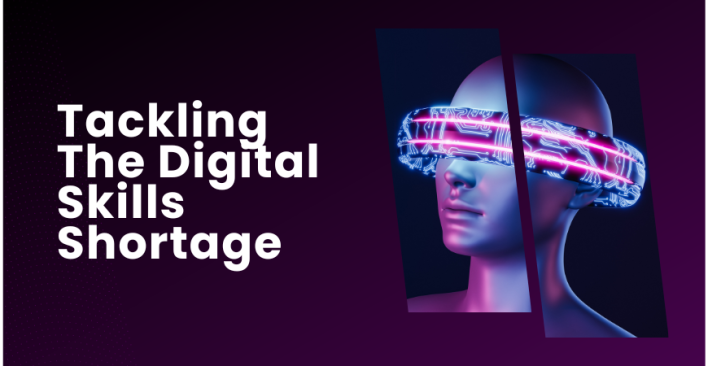Darren Morris on What a Mature Workforce Strategy Looks Like, Getting Statement of Work Right, and his Early Career Lessons

Early on in his recruitment career, Darren Morris found himself at Robert Walters in an era of rapid transformation. The recruitment consultancy was growing quickly but in a way that fostered team work, sharing and competition. Years later when a new employer handed him the coldest list of clients who had previously said “no”, he realised that in many cases “no” actually meant “not yet”, and with perseverance, relationship building and luck you could get that “yes”.
Now the director of client services at CXC Global, Darren uses these lessons to face new challenges, demonstrating to “not yet” organisations the opportunity to build an agile, competitive and successful workforce; a powerful asset in times of rapid change.
This week we talked to Darren about what he’s seeing in the market, if we will ever see a truly blended workforce, why managing Statement-of-Work (SOW) is so important, and how his early days at Robert Walters was a great case study on building a culture of success.

The Early Days at Robert Walters
So Robert Walters, as the business grew did two things that were amazingly effective:
Small teams
One, they kept breaking the teams down – so now we’re in banking, now we’re in front office and risk; now we’re in middle office and risk; now we’re in insurance and banking. They kept splitting the teams down in size, and didn’t let them get much more than 12, which was very much around this tribe mentality. I look back and see that that was incredibly successful.
Everyone is part of the same company but they’re in really tight teams, and the tight teams are competing against each other, and the competition creates better performance and better performance is more money for the company.
Building a culture of sharing and success
When I worked in London we were growing very quickly, and grew from 85 people to 2,500 people over 6 years that I worked there, almost all without acquisition. To hire someone everyone in the team had to give up an existing client or two. What happened was that some parts of the business were happier to give up a client to gain a team member, and their teams were growing much quicker, so their cultures were effectively becoming the dominate culture. Even though at the beginning people’s cultures were quite closed off “I can’t give you anything”, but the culture of growth overtook this because those people were prepared to give, and that culture overlapped the other.
Over time-to some extent- it became somewhat silly. The competition became how quickly, once you hired someone into your team, they could place and we’d have champagne to celebrate. So, it used to be you’d have a job lined up, you’d go see a client and have a job lined up to the point where you’d have a job lined up, you’d have the candidate lined up all they had to do was send the candidate to the client with the interview time prebooked
Why it worked
Some of those later placements, after I’d been there a couple of years, were made easily in the day, if not a couple hours after the person started. So, you’d have a team, everyone [in that team] had given you part of their business, everyone knows something about your business, everyone wants to see you succeed and succeed quickly- and you did. And you wonder why that business was so successful!
The Hardest Call List
My first job in recruitment was the complete opposite. I was given access to what they called ‘C boxes”, and that was because we had AB clients, and the C box was effectively the marketplace, with every client who had said “yes” taken out of it. Imagine the stoniest, hard to hoe field you could ever get. It was harder than the telephone book basically, because they’d taken out the people who had said “yes”. So the job was to go through the C boxes and build up a client patch.
You can see the difference in experiences from my first job run by a different approach to building a business and building someone up. Great lessons for me as in my first two jobs in recruitment. I learnt the hard way, and then learnt the alternative and different way, which stayed with me for life.
The Slow Evolution of Contingent
Futurists vs those in the trenches

It’s interesting when you read Simon Townsend’s and Kevin Wheeler’s comments on the future, and whilst there’s a lot of talk towards 2020 and 40-50% of the workforce being contingent, in the enterprise, it really feels very slow. It’s eking out of 1 – 2% growth in those sectors. So, the transformation towards a blended workforce where as much of half of the organisation is contingent seems a long way away. Perhaps that will be a tipping point and things will break out of this gradual progression.
It would be interesting to sit here another couple of years, because the last two or three it has been very slow movement, and we haven’t seen that transformational change of organisations saying it is all about our contingent workforce and we have a strategy.
Deloitte
Probably the only exception to date of organisations we work with is Deloitte, who are working towards a plan over the next three to four years which will transform their organisation into having a smaller core of permanent people, and having a much more flexible consulting and contingent workforce that sit around that core.

What’s Happening in the Market
One of the things we’re definitely seeing -whether it’s a drive through technology or the different tracks people are taking – is that companies are taking this approach of ‘blended’ career management or recruitment. So within their teams, they’ve moved away from having recruitment functions that only manage permanent, to actually expanding those teams out to engage and recruit non-permanent workers. In almost every case they’re using their applicant tracking systems and not managing statement of work.
Statement of Work
Statement of Work (SOW) is often left with procurement, perhaps left with other technologies to manage it and programs just looking at the talent of those more traditional temps and independent contractors.
Contract Management Services
Our organisation partners to provide what we call Contract Management Services (CMS) like engagement, payroll of contractors, on-boarding and off-boarding. There is a significant increase in the area of internal or outsourced recruitment functions managing contingent workforces under those programs
I think what will be interesting to see how this will evolve in areas of Statement of Work, which really are a challenge for those programs to manage as they are, as they go forward.
Managed Service Provider/ Vendor Managed Service
Whereas perhaps the other track that we’re seeing; and we’re definitely seeing a growth, is around the traditional MSP/VMS Model. This is where specialist functions are managing temporary and contingent, and increasingly SOW.
This area of increasing management of SOW is a phenomenon that is occurring now versus a few years ago when we saw much less of it.
The Rise of Fieldglass
If these programs are set out, they are much more aligned to the likes of Fieldglass or other technology. Fieldglass has definitely created a market position by their early investment here of a local presence and perhaps in the early days, not requiring an implementation fee.
Acquiring SAP
Whilst it’s a double edged sword, the acquisition of SAP last year certainly opened the doors to many more organisations. I think we can see this with penetration in the government market in particular – ATO, NSW government and beyond, as well as in the corporate space. They’re definitely closing more deals than they’ve ever done before.
We’re working with Fieldglass in one, soon to be two customers, and up until this year we’ve never worked with them outside of Rio Tinto. I think by the middle to the end of September this year, we’ll have four of our clients using Fieldglass, out of sixteen – so twenty-five precent.
Why this is important
I think this is significant because three quarters of those programs have a specialist VMS/MSP or contingent workforce program, and in more than half of them they are actually addressing SOW. I think that is the big challenge for those traditional blended recruitment functions – the ability to manage statement of work in the ATS is just not possible.
Benefits of Managing SOW
Controlling costs
I think there are a couple of areas. One is that not all SOW is equal. So for example, organisations today engage single worker MSA’s as SOW. Either they do that directly, or through small consultancy firms that may have a sister company that is an agency, or just maybe a one person organisation. The costs of that, in that engagement are typically higher than they would be in the more traditional sense, either on a temporary contact engagement or through another model. That’s the cost related area.
Managing risks
I think also that there’s a risk element that relates to this, where organisations who have consultants or individual contributors are getting exposed to. So, where someone engages as a SOW in an organisation as a sole trader, who is responsible for the payroll tax? Who knows about the engagement model they’ve put in place?
Creating a competitive process
The other area is just creating a competitive process around the engagement of SOW. I think in the acquisition and purchase of anything there’s competition, a fair market rate occurs, and so managing programs in a competitive way creates a fair market rate for the products or services. Where this is decentralised, there’s often a lack of a competitive process, which allows the price to be higher than perhaps it needs to be.
The cost savings opportunity when SOW is better managed
The Industries and Sectors seeing this Change
There are probably some leading industries who’ve been in this space for a little while, so some of the technology groups have led the market in contingent work management. Perhaps over the last few years some of the resources sector stepped in because of the talent shortage. I think the recent changes in commodity pricing are driving more resources based organisation, and organisations reliant on either the resources sector or project sector into that space. They’re moving into contingent workforce management, one for visibility, but also definitely for cost savings.
I’m not necessarily sure that it’s only sector driven, I think now we’re at that sortof tipping point. We’re getting to a point where people have enough exposure in different industries; they move between industries and collaborate. They’re taking that idea or experience and driving it into the industry they’re working in.
I still think it comes back to the basics around visibility, cost, risk management and efficiencies, and those drivers are always there in any sector.
Entering Phase Two of Your Contingent Workforce Strategy
It’s a subject dear to my heart. What I find interesting in working with organisation is even some of those basic premises, around cost savings or reporting and benchmarks are not always there.
I think there’s a maturing area around some of the basic programs and how they’re run (which I’ll get into in my session) and then there are some areas of a more sophisticated program which I think relate to discussions around SOW and what that starts to look like for an origination.
There’s been a lot of talk, in organisations that I’ve spent time with this year, around decision trees, and the appropriateness around the right work being done by in the right categories. I think this is an area of evolution in the more mature market. I’d like to think we’ll have some discussion around reporting, or more importantly into insights and benchmarks.
Holiday period
So some organisation will run a holiday break or enforce a holiday break for their contingent or contract workers. But, some organisations who have a mature program, don’t have a program in place; or they have a program in place but they don’t do any measurement in regards to saving; or have a target of what percentage are going to have this break; or how effective this program was against the targets they have.
Overtime
If we look at overtime and see that as I transition the management of workers on a day rate and an hourly rate, I squeeze out my overtime in my day rate. Perhaps a good program would know what that looks like for a savings perspective. But then maybe the evolution in a more mature program might have some targets around overtime- so what would overtime look like in an uncontrolled organisation? Are there some targets around overtime, and if that overtime is above that or below that what does that mean, and what should be done?
Good Program – would know what overtime looks like for a savings perspective.
Mature Program – would have some targets around overtime and if that overtime is above that or below that, an understanding on what that means, and what should be done.
Overtime case study
I worked with an organisation a couple of years ago to set up an award and that program looked at two things; one, overtime was principally being done by a very small group, should those people be permanent employees because they were given overtime work because they were the best people? Secondly, the award they set up was a 50 hour award, so what does that look like?
Using this data
Now, what do you do with the data once you identify that there are some learning’s, what are some of the benchmarks you should see? At CXC Global we see that our hourly rate or percentage spend on overtime for our hourly workers in 2%, which is the benchmark we have across 7000 contractors. So that sort of data, where is that in the market?
Using a Decision Tree
The basic premise would be to have some definitions around how you engage workers in different categories, whether they be an independent contractor or temporary worker or in statement of work, and setting out these definitions so that the hiring manager and organisation can use.
Most organisations look to have a series of questions or triggers that help people categorise the type of worker they need, and on the basis of that categorisation drive the hiring manager towards the right technology, or the right process, or engaging in the right area of the business to then go through the process of engaging those workers.
So in a very basic way we see people use technology [to do this], so Fieldglass has a decision tree and there’s talk that PageUp is developing their own decision tree to help run that process. Other organisations use their intranet site and some drop down questions, or a slide deck. So it can be unsophisticated or have a heavy investment, but it’s about working with the organisation to understand the rules and the definitions that drive that behaviour, which then ultimately sets up getting better and more appropriate use of the categories.
Case study
We’re working with a company at the moment who don’t have a VMS, but by using their financial systems they have significant clarity around the type of engagement; whether it’s a sole trader, whether it’s a trust, whether it’s a company etc. It’s very easy for them to pivot on that data and say “well actually there are some real risks around our sole traders, and we want to put a new model in place”. They can then go and say that these are our sole traders, this is when we engaged with them, and how much money we’ve spent with them. Even some planning and thought upfront can help you in later stages to pivot or change direction and do something different.
The Future of Work
Outcome based work/ SOW
One of the areas of incremental use is around the freelancer model, so it’s around this task based approach. What’s interesting for me is that there’s been a movement in converting SOW which is misclassified into the temporary and contingent space. What I think we will be seeing, and what is going to become more pronounced, is outcome based work. SOW when it’s done well is all about outcome based work. I think we’re going to see a shift towards outcome based work, and I think that might mean an increase in SOW and that is why it becomes more important for organisations to manage it. I think that the platforms as part of this will be small but incremental be part of the program going forward.
Future platforms
What’s surprising, and I expect this to change in the next 2-3 years is around technology. We’ve talked about Fieldglass, Beeline, but what’s the emerging software as a service product in that market space? Will workday invest or acquire something and move into that space? Will it just be an emerging technology? We really haven’t seen that many technologies in this space. I guess perhaps on the ATS front, we’ve seen it a little, but the ability to build technology on what’s required here is something that will emerge pretty quickly.
The blended workforce
What will get here first, the intelligent learning computer/robot or the blended workforce? It could be a race to the finish- a race to the bottom!
It still remains a great challenge for companies to do both, and what I can see occurring is areas like recruitment leading the way of being across that workforce in regards to how it’s engaged, perhaps moving into how it’s performing in the early stages.
I think this more utopian view, of people moving between permanent and contingent, six jobs at the same time, and an organisation being able to restructure itself to a core that allows them to say “I’m permanent and now I just want to work 2 days a week” is further away.
Technology as the great enabler
I think technology, as often is the case, is the great enabler for these things. It definitely has the potential to redesign organisations to the core of what they do. When you get to the fact that 20% /30%/50% of the workforce is the core, you get to see the other things that they do just being done by people at the edges.
There is a significant part of the workforce, stay at home mums for example, university students, who are not nearly engagement in the workforce as they could be in a better model. So the upside of this is the huge potential for releasing expertise or re-releasing expertise into the workforce, which would be hugely positive. I guess on the other side is that people say there is a shortage of skills, but unemployment continues to increase, so we kind of have this challenge around what’s diving it as well.
I think that what’s happening in the workforce today is one of the most exciting times to be employed. What will happen in the next 10-20 years is just going to be fascinating, and the area of contingent workforce is so underdone it creates fantastic opportunities to do really interesting work and to work with organisations in a period of quite transformational time
Keeping Healthy in a Demanding Job
I’m a part time swimmer given the weather at the moment. It’s important to look after yourself, you have to stay healthy. It’s very hard to perform and live an active life without being healthy. I’m lucky that I live fairly close to the beach in Sydney and I have a swimming spot where I swim from the beach to the headline and back which is about 1km. Its an opportunity to switch off and be part of nature in a weird way, in this very green enveloping ocean. It’s invigorating and something I love to do, it’s my time. It’s important to have time for yourself, time for reflection and time to stay healthy so I’m lucky.
To learn how you can start preparing for the future, and building the workforce of 2020, join Darren at #CWF15 in Sydney on 22-23 September. Darren will discussing how to further improve your contingent model to gain a competitive advantage. To participate, register your ticket for the event here.
Related articles
Leave a Reply
Sign up to our newsletter
Get a weekly digest on the latest in Talent Acquisition.
Deliver this goodness to my inbox!


